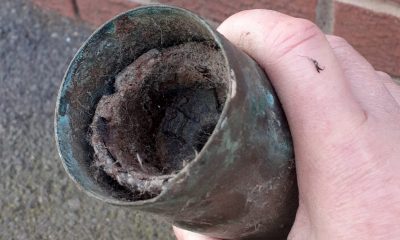Surgeon reveals unique things he’s removed from people’s hands
"In terms of things I've removed - everything, but now and then something will surprise me."
Published
1 year ago onBy
Talker NewsBy Jake Meeus-Jones via SWNS
A surgeon has revealed the unique things he's removed from people's hands - including sea urchin spines, fishhooks and bullets.
Nick Pappas, 43, has been a practicing orthopedic surgeon for 10 years and spends his time removing foreign objects, inserting metal plates and re-attaching fingers.
The hand specialist shared a list of recent things he's removed from hands.
First up on the list is screws - with Nick saying he often has to establish the brand of the screw to allow him to use the correct screwdriver to remove it.
He has also removed sea urchin spines after a patient fell onto one of the creatures - leaving spines embedded as far as the bone.
Nick also removes other things such as gangrene-infected fingers, BB gun pellets and electrical wire.
Nick says he's also had to remove snake bit venom, toxic paint from a high-pressure paint gun and what he says is the "most dramatic" - fish hooks.
He decided to work at a private hospital so he would have more freedom and recently started sharing the intricacies of his job on social media.
Nick, from New Orleans, Louisiana, said: "I've got a private practice so I can teach and use social media to teach and educate people.
"People are interested to know what it's like if they ever have hand surgery and I'm able to show what it’s like to have a certain operation.
"In terms of things I've removed - everything, but now and then something will surprise me.
"I had one guy with a snake bite, which can make the whole hand swell up like a balloon.
"He'd killed the snake after it attacked him and all the nurses were freaking out because the guy had a snake bite, the container and the dead snake which he'd brought with him.
"Another one is the high-pressure paint injuries when someone sprays paint with a high-pressure gun.
"It can shoot into their hand from their finger all the way to the palm or wrist area and that’s a surgical emergency because the paint can be so toxic.
"It can lead to amputation of the whole hand.
"Other times I see a lot of BB gun pellets and the patients don’t even realize they're in their hand and then show up six months after the incident, complaining of pain.
"I've also seen a lot of gunshots and, if it's a fragment of a bullet inside the bone, I usually leave it alone and observe it over time, but if it’s sticking out of the skin or a full bullet then you remove it.
"In general, surgeons don't remove bullets from the extremities unless they are causing pain, are very superficial, are in a joint, or are pushing on a neurovascular structure.
"Sometimes it can be more harmful to try to take it out than to just leave it in, as long as it's not causing any issues."
Before removing the object, Nick has an extensive routine which he undertakes in order to locate it.
He uses a strong x-ray and MRI and sometimes also uses an ultrasound to accurately locate the object.
"I make sure I have all the images possible and then if it's a screw I have to find where it entered and find the brand of screw and try different screwdrivers to remove the it," Nick said.
"It might be that the head of the screw is damaged, or the screw is stuck to the bone and I have to chisel it out of the hand instead.
"You need the right imaging and the right instruments. It can be challenging and it’s not always straight forward."
While he's often busy taking things out of people's hands - like sewing needles and a hand stuck in a meat grinder - Nick also puts things in patients' hands.
He said: "Sometimes when we take a bone out, we replace it with a patient's own tissue or sometimes I replace a joint with silicone.
"I also put in little pins, metal plates, silicone implants and if someone ruptures a tendon, we put little anchors in and we tie a suture around the tendon – I did one of those a couple of weeks ago.
"Some of the devices we put in allow people to start using the limbs straight away, so technology has come a long way."
The most common surgery Nick performs is carpal tunnel surgery, which involves cutting part of the carpal ligament to relieve stress on the nerves of those with carpal tunnel syndrome.
Most of his surgeries take as little as 30 minutes, however, he often does finger amputations and re-attachments, which he says can be challenging and time consuming.
He said: "I did one where I replaces someone's thumb with their big toe.
"It took 12 hours and can be very tricky because the size doesn’t always match up.
"If you mess it up and the blood vessels don’t work properly then it can lead to a bad outcome.
"Thankfully, this one was successful.
"That was probably the most challenging. To take one part of the body and move it somewhere else.
"I also had one that was done from a Samurai sword that took off three of his fingers and it took 10 hours to re-attach all the nerves, the tendons and the bones."
All the things Nick has removed from hands:
- Bullets
- Glass
- Metal wires
- Sewing needles
- Screws
- Metal plates
- Splinters
- Pine needles
- Sea urchin spines
- Catfish spines
- Arthritic bones
- Extra fingers
- Fingers with gangrene
- Rings the skin has grown over
- Medical needles
- Shrapnel
- BB gun pellets
- Stables
- Fish hooks
- Tumors like melanoma
Stories and infographics by ‘Talker Research’ are available to download & ready to use. Stories and videos by ‘Talker News’ are managed by SWNS. To license content for editorial or commercial use and to see the full scope of SWNS content, please email [email protected] or submit an inquiry via our contact form.
You may like


Meet the couple who’ve been on 9 naked cruises


Mom with mastectomy scars will be first to run London Marathon topless


Man recovers stolen motorbike through hidden AirTag


Woman shocked to find herd of cows outside her newly built home


Wedding photographer’s sidekick is his talented 10-year-old daughter


Woman gets paid $100 per hour to dress up as a Disney princess
Other Stories


One-year-old can’t stop laughing during first ride at Disneyland
"We didn't expect him to love it that much."


Dad running marathon wearing chainmail weighing over 40 pounds
A dad is attempting to break the world record for the fastest marathon while wearing chainmail.


Hero saves elderly couple by dragging them out of burning car
The Good Samaritan jumped into action after spotting the fire on his way to work.


Bomb squad seals off town after ammunition shell donated to charity shop
Staff discovered the device in a bag of donations.


Woman recovers stolen phone after chasing down thief
She was not going to let the thief get away.
Top Talkers

 Parenting1 day ago
Parenting1 day agoSingle mom details struggles of feeding her 12 kids

 Broadcast3 days ago
Broadcast3 days agoOver 40% of Americans have no clue what a 401k is

 Broadcast1 week ago
Broadcast1 week agoGrocery shopping hungry is costing Americans this much

 Funny1 week ago
Funny1 week agoCops confused by crow mimicking police siren

 Broadcast2 days ago
Broadcast2 days agoHow hard is it for Americans to live sustainably?

 Shopping1 week ago
Shopping1 week agoGrocery shopping hungry costs Americans this much every trip

 Money3 days ago
Money3 days agoOver 40% of Americans have no clue what a 401k is

 Parenting1 week ago
Parenting1 week agoIt takes this many minutes for the average American kid to get bored
